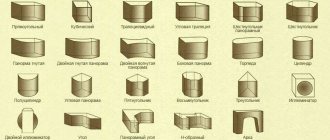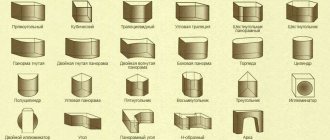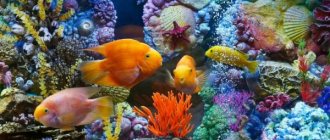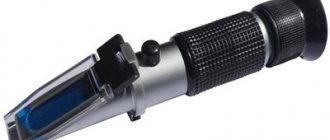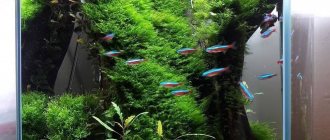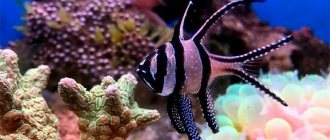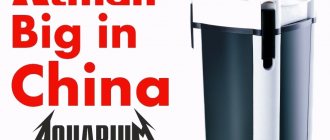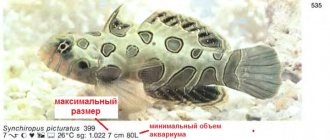The first questions that novice aquarists who decide to set up a marine aquarium on their own ask themselves are “where to start” and “what is the best way to take on this matter.” With this article we will try to answer not only these questions, but also the questions: “what”, “where”, “when” and “how”.
First, you need to understand human psychology a little. We live in a fast and ever-expanding world and are accustomed to quickly satisfying our needs with the help of various online stores and delivery services. However, a marine aquarium is a complex microbiological system, and bringing such a system into biological equilibrium overnight is extremely difficult, and in some cases impossible. Starting a marine aquarium yourself is not just about purchasing all the components in an online store and then installing them according to the available instructions. This requires a thorough analysis of the entire process in order to ultimately achieve the creation of an impressive living picture of a fabulous underwater sea kingdom.
The first step to success is choosing the right equipment. If the equipment does not live up to the expectations placed on it, the hobby for a marine aquarium may end before it even begins, because it is unlikely that anyone will want to spend a lot of money on this venture again.
Why do you need a filter in an aquarium?
A filter is an essential element of an aquarium, without which the life of fish and other living creatures living in it is impossible.
Only a large number of plants in the aquarium can replace the filter, but creating such an environment is not always possible, since with abundant vegetation in a small space, the fish will live cramped and uncomfortable. Aquarium filters consist of several parts:
· pump pumping water;
· air tubes;
· cartridge with filter.
The main purpose of a filter in an aquarium is mechanical and chemical purification of water from various contaminants, turbidity and fish waste products.
Home sea feature
The maintenance of inhabitants in sea and fresh water has significant differences. To create comfortable conditions in a container with salt water, you need to put a lot of effort, patience and money.
Having decided on its arrangement, it is necessary to take into account the factors that determine the possibility of a comfortable stay for its inhabitants. Among the most significant are the following:
- lighting;
- water circulation;
- presence of oxygen in water;
- hardness and salinity of the liquid.
To ensure the normal level of these indicators, you cannot do without special equipment.
The marine aquarium is a complex, contained world that requires a large amount of sophisticated equipment and care.
Types of filtration in an aquarium
Based on their filtering capabilities, devices are divided into several types.
Types of filters:
1. Mechanical - water is filtered through a special sponge that retains fish waste products.
2. Biological phytofilter - water purification is carried out by beneficial bacteria that process waste products of the inhabitants of the aquarium.
3. Chemical filters with special fillers that cause a natural chemical reaction, due to which water is purified from various contaminants. The filler can be zeolite, activated carbon and other materials.
Choosing a Marine Aquarium
Before you start choosing equipment, you need to decide on the size of the aquarium, since its dimensions are definitely of great importance. For example, compared to large tanks, nano aquariums are not easy to maintain, and maintaining stable conditions in them is quite a task, but the larger the aquarium, the more expensive it is. Therefore, here you should weigh what you want with your financial capabilities and choose the largest aquarium you can afford. It is interesting that, compared to nano aquarists, people who bought large aquariums not only remain interested in marine aquariums longer, but are 70% more successful in keeping marine animals. This is a clear example of the benefits of high volume. It is also known that on a biological and chemical level, large aquariums are more stable, but most importantly they have more space to accommodate the maximum possible number of fish and corals, which is the dream of many aquarists.
The next thing to think about is filtering. The filter that is connected to the saltwater aquarium will be its circulatory system, vital organ and everything else that can ensure that the beauty of the aquarium display is maintained at the proper level. You can also hide other equipment that will be used in it. The choice of filter must be taken very seriously. Many filters do not give satisfactory results, and moreover, some filters are generally not recommended for beginner aquarists to use in a saltwater aquarium. Canister filters are usually not suitable for large saltwater aquariums, while the best solution, in our opinion, is a custom-made sump filter designed for a specific large aquarium.
Recommended filtering options
The sump filter, or, as it is called abroad, a sediment filter, is the most understandable and often used in marine aquarium keeping. As an alternative, you might consider a remote open (gravity flow) filter. The key word here is “open,” which implies the ability to maximize gas exchange. Other filtration means, such as side filters often found in freshwater aquarium hobby, are also used, but with limited success. Some marine aquarists like to use hang-on filters, which are usually made to order. However, bottom and canister filters intended for use in freshwater aquariums should not be used in marine systems. This statement is controversial, and someone may have a different opinion, but here is what we think about it.
Canister and bottom filters designed to reduce ammonia and protein levels produce phosphates and nitrates, which are not a major problem in a well-maintained freshwater aquarium, but are completely unacceptable in a saltwater aquarium. Whereas a well-designed and properly maintained sump filter produces much less phosphates and nitrates and, to some extent, can help reduce their levels - if configured correctly.
How to choose the right sump filter? The size of this filter should be at least 50% of the volume of the aquarium, and if it is, for example, larger than the aquarium itself, that’s even better. How is the sump filter superior to other filters? For beginners, this filter can be designed to hide all other equipment. Moreover, it increases the volume of aquarium water, enhances the oxygenation of the water, and has space to accommodate: live stones, a thick layer of sand or any other means of filtration, stabilizer - at the initial or later stage. And the appearance of the aquarium display does not suffer much! In addition, caring for the settling filter is quite simple, while the tasks it performs are vital for all aquarium inhabitants: neglecting them leads to dire consequences.
Main types of aquarium filters
Depending on the type of equipment and its equipment, water filtration in an aquarium is performed in different ways. Let's look at the main types of aquarium filters, their features and advantages.
External filter
External filters are the most expensive type of equipment that perform highly effective mechanical, chemical and biological water purification simultaneously. The device is fixed on the outside of the aquarium, and only two suction tubes are placed in the water. Through one of them, water is pumped into an outer housing with various fillers, after passing through which, the purified liquid is again supplied to the aquarium through the second tube.
Advantages of external filters:
· multi-stage cleaning system;
· high performance;
· long service life;
· Suitable for cleaning aquariums of different sizes.
To effectively purify water in an aquarium, it is necessary to clean the filter itself at least once every 2-3 months.
Internal filter
The most popular type of equipment is an internal aquarium filter, characterized by low cost and average operating efficiency. This device is placed directly into the aquarium water. The design contains a filler sponge, which cleans the liquid. The equipment also includes a plug and a hose, thanks to which the water is not only filtered, but also aerated.
Pros of internal filters:
· low cost;
· safe operation, water will not leak out of the aquarium during filtration, which is due to the internal location of the filter housing;
· easy maintenance, the filter sponge is quickly cleaned of dirt by washing.
The disadvantages include the low quality of water filtration and the need for frequent cleaning of the filter sponge (once a week).
Bottom filter
Bottom filters can be used in aquariums of different sizes. The design consists of a pump, a tube system and a fine-mesh grid. Water purification is carried out naturally - with the help of soil.
The bottom filter tubes are placed at the bottom of the aquarium, a grid is installed on top, on top of which a layer of soil is laid - pebbles or small stones.
The system works according to the following scheme: water from under the grate is pumped out through a pump, passes through the filter material, and then is cleaned of large soil contaminants. During the process of water filtration, soil aeration also occurs, which helps strengthen the root system of algae and their rapid growth. The main thing is to prevent oversaturation of the soil with oxygen, which will negatively affect the growth of vegetation in the aquarium.
Advantages of a bottom filter:
· high-quality mechanical and biological water purification;
· thanks to the continuous water cycle, the risks of spreading infection are eliminated;
· quiet operation of the device;
· aesthetics, inconspicuousness from the outside;
· creates an optimal microclimate for the existence of fish.
The main disadvantage: the filter tubes often become clogged with dirt and require cleaning, which can only be done by draining the liquid and completely disassembling the bottom device.
Airlift filter
Practical and reliable, airlift filters are the lowest-power type of aquarium equipment. They are sold at low cost. The principle of operation is as follows: the compressor pumps air, the flow of water rushes upward and, entering the tube where the filter element is installed, is cleaned from mechanical impurities.
Airlift filter functions:
· enriches the liquid with air;
· ensures constant circulation of water in the aquarium;
· Performs mechanical cleaning of the liquid.
Cons: low efficiency, the device does not create a powerful flow of water, so the sponge absorbs little organic matter. Only suitable for cleaning small aquariums with a small number of fish.
Other types
There are other types of aquarium filters. For example, a phytofilter is a highly effective device that performs high-quality biological cleaning. Such filters are not commercially available; you have to create them yourself using natural porous fillers.
Water circulation
The movement of water in containers is extremely important for the normal functioning of invertebrates, algae, corals and other inhabitants that cannot live without water circulation. Thanks to this process, food and oxygen are supplied and toxic elements are removed.
The flow pump ensures the movement of water in the aquarium.
This process can be ensured by using a flow pump. Based on their operating principle, they can be divided into the following types:
- With a constant flow. Ensure uninterrupted water circulation.
- Equipped with a control unit. They have the ability to regulate the strength of liquid current, which leads to the formation of vortices.
- With a wave system. Promotes the formation of waves, creating an attractive visual effect.
Over the course of an hour, the movement of water should be at least 3 parts of the volume of total water. It is impossible to organize comfortable living conditions for residents without the use of circulation pumps.
Features of using filters
In order for the aquarium filter to work effectively and not have a negative impact on the residents of the artificial pond, you need to correctly install the structure and comply with some operating requirements recommended by the manufacturer.
Installation
External filters are installed behind the walls of the aquarium in a special cabinet, and two hoses are lowered into the water - suction and outlet.
Internal filters are attached to the wall inside the aquarium. The device is completely immersed in water, the optimal height of the water level above the top point of the body is 2-5 cm. The filter includes a flexible tube for air supply. One part of it is connected to the body submerged in water, the second is brought out into the open air.
After installing the filters, you need to test the operating mode of the device, having first removed all living creatures from the aquarium. If the filter is functioning normally, the fish can be reintroduced into the aquarium.
Exploitation
It is necessary to follow some rules for the operation of aquarium filters, which will ensure normal living conditions for its inhabitants.
Operating rules:
1. Regular cleaning of filters.
2. Continuous water filtration.
3. Compliance with safety regulations. Do not put your hand in the water if the filter is on.
4. The indoor unit starts up only after it is completely immersed in water.
Aerofilter
A simpler design is suitable for depositors. It does not require significant costs. Made from scrap materials. Used to purify water in small swimming pools. It is easier to make an aquarium air filter yourself than to purchase an expensive device.
To make it you will need:
- Plastic bottle,
- Scissors,
- Sucker,
- Gauze,
- Foam rubber or cotton wool,
- Rubber.
The top of the bottle is cut off along the lower “skirt”. This makes it easier to secure the elastic. The bottom of the bottle must be cut carefully, without burrs. The resulting pipe is cut lengthwise, the corners are cut into a smooth line. The blank is rolled into a tube and inserted into the neck of the bottle. You can secure the tube with a ring from the cap. A hole is made in the body of the bottle for a suction cup.
The size of the gauze should be such that it can be secured with an elastic band.
Foam rubber or cotton wool is inserted into the resulting structure and a hose from the compressor is inserted.
How to choose the right aquarium filter
Each filter has its pros and cons. To purchase the right unit for your aquarium, there are some features you should pay attention to.
Important selection criteria:
1. Volume of the aquarium. Each filter is focused on purifying a certain volume of water. Buy a design of suitable performance with a reserve of 10 liters.
2. Device power. This parameter determines how long it will take to purify the water. The most powerful filters pump 400-600 liters of liquid in 1 hour. This type of equipment is optimal for installation in large aquariums.
3. Type of filtration – mechanical, chemical, biological treatment.
4. Type of filter filler.
5. Economical power consumption.
6. Adjustment of the pressure of the outgoing flow. Some fish love a calm atmosphere, and if purified water is supplied back under high pressure, they may die. To avoid such consequences, it is recommended to choose a filter with a fan mode of water injection, which ensures uniform distribution without pressure.
7. Noise level during operation.
Light level adjustment
An optimal microclimate can only be created if lighting is properly organized. For this purpose, lamps with different spectrum and power are used. Taking into account these characteristics, when equipping a marine aquarium, it is recommended to use the following types of lamps:
Daylight T8
Mounted on the lid of the aquarium. Used primarily for aquariums of small height and volume. Such lamps have low power and are affordable. If we talk about their disadvantages, we can only mention their length, which complicates the operation process.
Daylight T5
Despite their short length, their power is significantly higher than that of the previous model. They are easy to use and install.
Metal halide
Power ranges from 250 to 500 W. Thanks to this, light is perfectly scattered in the water column. One lamp is enough to provide the required level of illumination for a pond 80 cm high.
When choosing the type of lamp, you need to take into account the volume and height of the container. It is also important what kind of inhabitants live in the aquarium.
07:07
Marine Reef Aquarium - Lighting
07:20
Aquarium science: light for corals in a marine aquarium.
Auto top-up
AUTO-TOP-UP can add water to both the BIOfilter and SAMP. The auto-topping pump turns on when the water level decreases below the level sensor. Setting the auto-topping pump activation time. It can be configured with a professional automatic top-up system to top up water directly from the water supply or reverse osmosis filter. Auto top-up is NOT included in the basic Automatic filter kit. Ordered as an option. Enjoy your favorite hobby without hassle!
